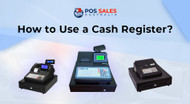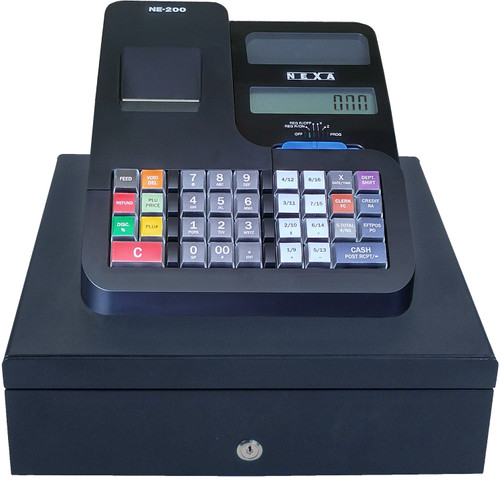How to Use a Cash Register?
Until the onset of the 20 th century, retail transactions were recorded manually. The process was not just tiring and time-consuming but often-a-times fallible too. Eventually, a sturdy device was created to handle cash transactions, known as cash register often referred to as a point of sale (POS) device. The earliest known mechanical cash register was invented by a Dayton, Ohio-based entrepreneur, James Ritty who designed the device primarily to store and track cash transactions in his store.
Primarily, there are 4 types of cash registers:
- Electronic Cash Registers (ECR): These are the electronic version of mechanical cash registers. Compact in design, these devices are feature-rich and can connect with payment terminals, providing you with the convenience to process credit card payments in your store too. These devices can calculate and add the tax to the purchase amount automatically too.
- Point of Sale (POS) Cash Registers: Point of sale (POS) systems have revolutionized the world of cash registers. Modern-day point of sale (POS) cash registers add new features to the electronic cash registers (ECR) and come with hardware components and a software that allows you to process payments in your store. These flexible solutions provide retailers with an array of services like inventory management, product performance analysis, sales reports and metrics, employee management, customer relationship management (CRM), loyalty programs, sales, promotions, discounts, and more.
- Mobile Cash Registers on Tablets: The popularity of mobile point of sale (mPOS) systems allows retailers to conduct their business from any location within the store using a tablet point of sale (POS) system. These devices come with features that traditional solutions offer but are comparatively less expensive. Since tablets can be carried around easily, payment processing can be done on the go. However, the processing power of tablets is less compared to desktops and is more prone to theft.
- Cloud-based Cash Registers: Modern-day cash registers are cloud-operated and offer several benefits and great flexibility. These offer great connectivity and can be connected through any device with internet access, from any remote location. The data stored in the remote server is mostly updated in real-time, allowing business owners to track and manage sales, inventory, orders, promotions, and more conveniently. Also, since the data is stored on remote servers, it is secure.
In this blog, we have discussed the steps to set up and use a cash register.
How to Set Up and Use a Cash Register?
To set up a cash register,
1. Place the Device in the Right Spot: Ideally, you should place your cash register along with your point of sale (POS) terminal where you can process customer payments. Ensure you place your device on a flat and hard surface and plug it into an electrical outlet.
P.S. It is advisable not to plug your cash register directly into the socket.
2. Install the Battery: The device battery works as a backup power supply in case there’s a power failure at your store. So, installing the battery is vital. To do so, you need to remove the receipt cover. Since the battery compartments are placed below the receipt area, you can open the cover using a screwdriver and follow the user manual to insert the battery into the cash register and close the battery compartment. Make sure you change the battery once a year for optimum performance.
3. Install the Paper Rolls: To do so, you need to open the cover of your receipt drawer and pass the rollover and place the roll at the front of the register which would ease the receipt printing process for your cashier. Press the ‘feed’ button and take a test run. Ensure the end of your paper roll has straight edges for it to load easily in the input tray.
4. Unlock the Drawer: You would get a key along with your cash register to open the cash drawer. Make sure you don’t lose the key; hence, it’s better to keep the key in the drawer during your daily working hours. At the end of the day, you can lock the drawer and carry the key with you.
5. Switch on the Cash Register: Usually, the on/off switch is on the side or the back of the cash register. But, there are also cash registers that open and close with a key that needs to be turned to the REG position. The latest models of cash registers come with a ‘mode’ button, pressing which you can activate the cash register.
6. Device Configuration: While running a retail store, you would stock commodities that are both taxable and non-taxable, and would also want to set the date and time of these products. These devices usually come with function buttons that you can use to set the function you require. For example, there are cash registers with 4 tax buttons that allow you to set different tax rates including VAT, GST, and PST, depending on your location. Refer to your manual to install all your desired functions.
7. Integrating your Device with Other Point of Sale (POS) Devices : Different point of sale (POS) hardware components that come with your point of sale (POS)cash registers include cash drawers, credit card readers, receipt printers, and a barcode scanner that can be connected via Bluetooth or through wires. You need to ensure that all your hardware components are compatible with each other and are fully integrated with the software you choose for the smooth functioning of your device.
There are different types of software that cash registers use. Let us take a quick dive into it.
Types of Software that Cash Registers Use
1. Embedded Software: Known as firmware, embedded software is written into memory chips placed inside the register during manufacturing. These software are programmed to perform several functions including checking for prices, calculating sales tax, printing daily sales totals, or saving history to an on-board memory card.
2. Communications Software: These cash registers come with hardware and software that are integrated and programmed to share data with other registers and communicate with banking services. Some devices come with the communication software as a part of the manufacturer’s firmware, or you can store them separately.
3. Point of Sale (POS) Software: This type of software is used with complex cash registers and combines cash registers with communications software with networked personal computers or servers. When a transaction gets processed, the software tracks sales volume, tracks inventory levels, and notifies the store manager about products that are running low on stock. These systems provide precise and accurate data.
Steps to Run Transactions on your Cash Register
1. Login: Start by entering the security code/password. There are cash registers that use employee IDs or emails to associate sales orders with a specific cashier which helps business owners track employee performance.
2. Enter Necessary Information: Enter the exact quantity of the item when processing a customer payment. Categorise the item based on the product type (for example, food or clothing items) and choose the tax rate corresponding to the product category. You can connect the advanced cash registers with a barcode scanner that can scan barcodes from the products and fetch product details automatically instead of entering them manually.
3. Add a Discount or Gift Card Coupon Code: Enter the discount percentage to use the discount code by pressing the ‘department’ button where you’ll need to enter the discount percentage.
4. Choose the Payment Method: Since modern-day retail stores are required to accept payments via different payment methods like cash, credit/debit cards, cheque, or other third-party payment modes, you would need to be equipped to provide your customers with the same level of convenience for an amazing shopping experience.
To process cash transactions, you would need to enter the cash amount and press either the ‘cash’ or ‘AMT TND’ button placed on the bottom right part of your device. Advanced cash registers machine display the amount you need to return to your customers.
For credit card transactions, press the ‘credit’ or ‘CR’ button and enter the required amount into the credit card machine and run it.
To accept a cheque transaction, enter the amount written on the cheque and press the ‘CK’ button.
5. Print a Receipt: On pressing the ‘feed’ button or arrow keys, you can bring the receipt up and read the total from the receipt.
Wrapping Up,
Wondering which type of cash register till is going to be perfect for your retail business?
Know that the right device will help you streamline several business functionalities including inventory management for both online and offline stores, creating customer profiles for personalising marketing campaigns, setting up staff roles for tracking employee performances, adding products and creating barcodes, accepting different modes of payments, and a lot more.
If you are planning on purchasing the perfect Cash till Drawers for your business, POS Sales Australia is your one-stop shop. We are Australia’s leading online reseller of point of sale (POS) hardware, consumables, accessories, and bundles, all available at competitive prices. You can either browse through our inventory and place your order with us or contact us for personalised assistance if you are unsure about your choice of device.


